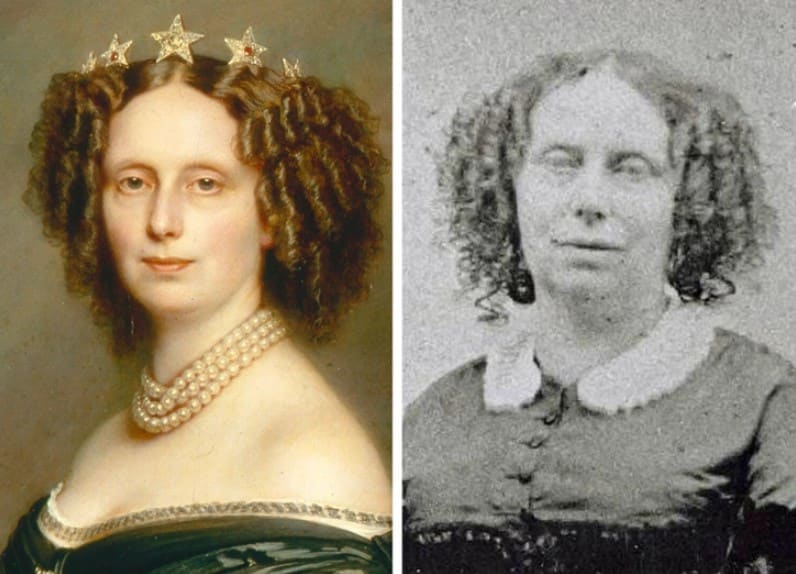7 Paintings Of Historical Figures Whose Portraits Depart From Their Real-Life Looks
Even in the past, people sought to perfect their portraits, often hiring experts to retouch photos. Back in the 1800s, painters even worked on making models appear more beautiful than they really were. But sometimes, these portraits don’t convey the whole reality. In this article, we’ve compiled six historical figures whose portraits differ from their real images.
1. Sophie of Württemberg, Queen of the Netherlands (1818 — 1877)

In 1863, Franz Xaver Winterhalter painted a striking portrait of Sophia Frederika Mathilda, Princess of Württemberg. She served as Queen Consort of the Netherlands from 1863 to 1873. Dressed in Victorian fashion, Sophia wears a stunning pearl necklace and a sparkling tiara, reflecting her royal status. Winterhalter’s use of vibrant colors and attention to detail gives the painting a special historical significance.
As a leading portrait artist of the 19th century, Winterhalter skillfully captures Sophia’s royal presence and the elegance of her era. This portrait is not only a treasure for art collectors but also a glimpse into Europe’s cultural heritage and the importance of the Dutch monarchy at that time.
2. Queen Victoria (1819 — 1901)

In 1887, an unknown photographer captured a powerful portrait of Queen Victoria, giving us a glimpse into her regal presence and lasting impact on British history. Victoria became queen at just 18 when her uncle, King William IV, passed away. She ruled for an impressive 64 years, from 1837 to 1901, during a time of big changes for the UK and the world.
In this picture, Victoria, older and wiser, wears a serious expression that shows her strength and determination. Her royal clothes, with the Order of the Garter, remind us of her status as queen and leader of the British Empire. 1887 was a big year for Victoria—it marked 50 years since she became queen.
To celebrate, there was a huge parade in London with hundreds of thousands of people, and lots of special things were made to honor her. This portrait captures Victoria’s influence and the important role she played in shaping British history.
3. Elizabeth Bowes-Lyon, the mother of Queen Elizabeth II (1900 — 2002)

In 1937, there was this beautiful painting of Queen Elizabeth that really showed off her grace and elegance. John Saint-Helier Lander painted it, and he did a great job capturing her style. Queen Elizabeth, born in 1900, was known as the Queen Mother later on. She was married to King George VI of the United Kingdom.
This painting makes her look timeless and charismatic, like she was in her early days as a royal. She’s wearing this stunning white dress that goes perfectly with her brown hair, and it just screams sophistication. The black and white colors in the painting give it this classic vibe that’s hard to ignore.
It was published in The Illustrated London News Volume 190 by The Illustrated London News and Sketch Ltd. in 1937, so it’s a piece of history. Looking at this painting takes you back to the fancy thirties when the royals were the talk of the town.
4. Isabella II of Spain (1830 — 1904)

In the 19th century, Federico de Madrazo y Kuntz painted a captivating portrait of Isabella II, the former Queen of Spain. Now, this remarkable artwork resides in the esteemed Museo Nacional del Romanticismo in Madrid.
Isabella II’s royal presence is evident as she confidently meets the viewer’s gaze. Dressed in elegant attire and adorned with intricate jewelry, she exudes regal authority. Yet, her calm expression reveals a strength and determination within.
Through clever use of light and shadow, the artist brings depth to the painting, creating a compelling visual narrative. Vibrant colors and meticulous attention to detail showcase Madrazo y Kuntz’s artistic prowess. Isabella II symbolized the romantic era, embodying not just political power, but also a deep appreciation for culture and beauty.
5. Princess Helena of the United Kingdom (1846 — 1923)

This portrait was painted by Franz Xaver Winterhalter, a German painter and lithographer. He was famous for making flattering portraits of important people in the 1800s.
Queen Victoria, along with Princess Louise and Princess Helena, was at the Rosenau palace in Germany when Winterhalter came to paint them in August 1865. Princess Helena was wearing a white evening dress and the badge of the Order of Victoria and Albert.
6. Victoria, Princess Royal, Crown Princess of Prussia (1840-1901)

German painter Franz Xaver Winterhalter also painted the portrait of Victoria, Crown Princess of Prussia. Princess Victoria was the eldest daughter of Queen Victoria and Prince Albert.
The portrait shows her wearing a white evening dress and badges from important orders. In 1858, she married Frederick William, the Crown Prince of Prussia. Her portrait, along with one of her husbands, was displayed in the Kaiser Friedrich Palais in Berlin.
7. Vincent van Gogh (1853 — 1890)

Vincent van Gogh’s “Self Portrait” from 1889 shows his later style and deep thoughts. He paints himself with a full beard and mustache, wearing a stylish jacket. The colors he uses are bold and exciting, making the picture come alive.
You can see how he puts his feelings into every brushstroke, mixing strong lines with soft details. By playing with light and dark, he makes his face look real and full of emotion. This self-portrait tells us a lot about van Gogh’s love for art, even when life was tough. It’s like a window into his world, showing his passion and determination.

